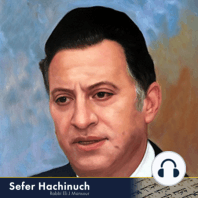20 min listen
Misva #98: The Kindling of the Menorah in the Bet Ha’mikdash
FromSefer Hachinuch
ratings:
Length:
20 minutes
Released:
Dec 20, 2021
Format:
Podcast episode
Description
In the beginning of Parashat Tesaveh (Shemot 27:21), the Torah commands that the Kohanim should arrange the candles of the Menorah in the Bet Ha’mikdash each day – “Ya’aroch Oto Aharon U’banav…” Needless to say, G-d does not need us to provide light for Him; He is the one who illuminates the entire earth. However, as the Sefer Ha’hinuch repeatedly emphasizes, the Torah’s commands are given for our benefit, because of the positive impact and effect that they have upon us and upon our lives. In this instance, the Sefer Ha’hinuch explains, we are commanded to light a candelabra in the Bet Ha’mikdash because people who want to make their homes look beautiful and majestic ensure that they are well lit. This was particularly so before electric lighting, when candles and candelabras were needed throughout the home in order for the home to have a warm, impressive appearance. The atmosphere in the Bet Ha’mikdash was intended to instill within those who visited a sense of awe and reverence for G-d, and thus, as part of the effort to create this atmosphere, the Torah commanded that lights be kindled there. The illumination contributed to the general aura which would help motivate and inspire the people to draw closer to G-d. The Sefer Ha’hinuch adds that this is the reason for the kindling of the Menorah on the level of Peshat – the simple, straightforward understanding. He concedes that the scholars of Kabbalah are aware of deeper, more profound explanations behind the significance of this Misva. The lamps of the Menorah were kindled each and every day in the Bet Ha’mikdash (as opposed to our kindling of the Hanukah lights for eight nights, which commemorates the Hanukah miracle, not the daily kindling of the Menorah in the Bet Ha’mikdash). The Torah refers to the light of the Menorah as a “Ner Tamid” (“constant flame”), indicating that this Misva overrides the Shabbat prohibitions, and thus the Menorah was lit even on Shabbat. The word “Tamid” (“constant”) instructs that the given Misva must be performed even on Shabbat; for example, the daily sacrifice – “Korban Tamid” – was offered even on Shabbat. By the same token, the Menorah was kindled even on Shabbat. Each lamp of the Menorah needed to be filled with a half-Log of olive oil for the kindling. The Sages determined that this was the quantity of oil needed to sustain the flames throughout the night during the period around the time of the winter solstice, when the nights are longest, and so this amount was established as the standard quantity of oil required. The Misva to light the Menorah includes also the obligation of “Hataba” – preparing the Menorah by cleaning the lamps, changing the wicks, and pouring new oil. The Ner Ha’emsa’i – the middle lamp – was to always remain lit. If it was ever extinguished, it would be kindled anew from the fire on the Mizbe’ah Ha’hison (the altar in the outdoor courtyard of the Bet Ha’mikdash). All the other lamps were lit from this candle; they had long wicks which were lit from the flame of the middle candle. The Rambam controversially maintained that the obligation to kindle the Menorah and the obligation of Hataba both comprise a single Misva. The vast majority of Rishonim (including Rashi, the Rashba, the Ramban and the Ra’abad), however, disagreed, and held that these are two separate Misvot – to prepare the Menorah for lighting, and then to light it. The Rambam also advances another surprising, unique view regarding the kindling of the Menorah, claiming that this does not need to be performed by a Kohen. The conventional understanding is that the kindling, just like the other rituals in the Bet Ha’mikdash, must be performed specifically by a Kohen. Indeed, the Sefer Ha’hinuch writes explicitly that this Misva is charged upon the Kohanim. The Rambam, however, in Hilchot Bi’at Mikdash (9:7), writes that even a “Zar” – somebody who is not a Kohen – is suitable for the kindling of the Menorah. He draws proof from the Gemara’s comment in Maseche
Released:
Dec 20, 2021
Format:
Podcast episode
Titles in the series (100)
Misva #19: The Prohibition Against Eating Hametz on Pesach: Daily Sefer Hachinuch - Brought to you by itorah.com by Sefer Hachinuch
